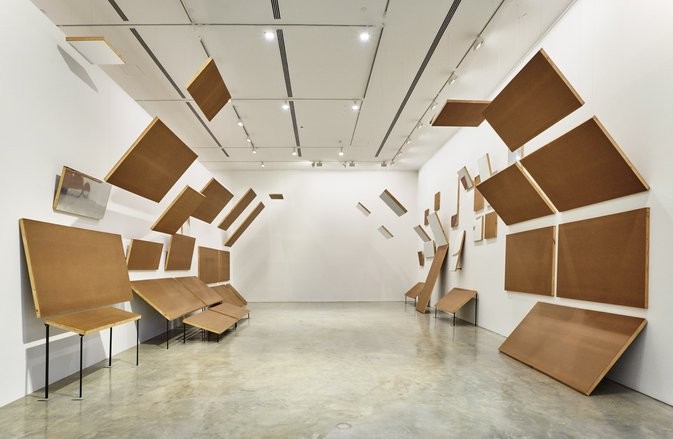Taking It All Away: MCA Collection
18 Dec 2014 - 22 Feb 2015
TAKING IT ALL AWAY: MCA COLLECTION
Gordon Bennett, Christian Capurro, Peter Cripps, Gail Hastings, Robert Hunter, Rose Nolan, Stuart Ringholt
18 December 2014 - 22 February 2015
Curator: Natasha Bullock
What might happen if you took away time, so a 24-hour day was condensed into 18 hours? What are you left with after 260 volunteers have spent five years erasing a magazine by hand – page by page?
These questions about our relationship to time, and how it might be spent and measured, represented one line of enquiry within Taking it all away, an exhibition of works drawn from the collection of the Museum of Contemporary Art Australia. This selection of work also speculated upon the continued importance of minimalism and conceptual art, the processes of erasure and abstraction, and the social impact of art.
In 1960s New York, minimalism and conceptual art transformed how artists thought about space and materials. Minimalism is characterised by seriality, industrial materials, geometric forms and the complex articulation of objects in space. In different ways and through the prism of the contemporary moment, Peter Cripps, Gail Hastings and Robert Hunter explored how art enhances our awareness of spatiality and temporality. Through mirrored surfaces, barely perceptible painted grids and objects to walk around, these works revealed the interaction between gallery and spectator.
The origins of minimalism can be traced to the early twentieth-century revolutionary art movement constructivism, which demanded that art reflect a rapidly industrialising society; and to suprematism, which proposed art’s capacity for transcendence through a radical geometric abstraction. Gordon Bennett’s etchings featuring black squares directly referenced these origins of abstraction, while Rose Nolan’s banners recalled the radical aesthetics of constructivism’s political slogans. Yet hers were a call to arms of a more individualistic nature, in which party ideology was pared back to personal anxiety.
Ideas and process are paramount for conceptual artists, as they are at his time for Christian Capurro and Stuart Ringholt. Exploring concepts of labour, expenditure and the body in an image-laden world, Capurro’s erased magazine passed through the hands of 250 people over five years. Ringholt’s 18-hour clock was not only about the potential impact of time being taken away but also the cosmology of the world and our place within a vast universe.
Diverse in form and character, the works in Taking it all away: MCA Collection set the dynamics of space and time against the complexities of modern existence. Together, these works spoke of the importance of art history and to the vigorous, evolving nature of contemporary art.
The Museum of Contemporary Art Australia dedicated this exhibition to the memory of artists Gordon Bennett and Robert Hunter, who sadly passed away during its development.
The Museum of Contemporary Art Australia gratefully acknowledged the MCA Foundation whose support and generosity enabled the acquisition of a number of works in this exhibition.
Gordon Bennett, Christian Capurro, Peter Cripps, Gail Hastings, Robert Hunter, Rose Nolan, Stuart Ringholt
18 December 2014 - 22 February 2015
Curator: Natasha Bullock
What might happen if you took away time, so a 24-hour day was condensed into 18 hours? What are you left with after 260 volunteers have spent five years erasing a magazine by hand – page by page?
These questions about our relationship to time, and how it might be spent and measured, represented one line of enquiry within Taking it all away, an exhibition of works drawn from the collection of the Museum of Contemporary Art Australia. This selection of work also speculated upon the continued importance of minimalism and conceptual art, the processes of erasure and abstraction, and the social impact of art.
In 1960s New York, minimalism and conceptual art transformed how artists thought about space and materials. Minimalism is characterised by seriality, industrial materials, geometric forms and the complex articulation of objects in space. In different ways and through the prism of the contemporary moment, Peter Cripps, Gail Hastings and Robert Hunter explored how art enhances our awareness of spatiality and temporality. Through mirrored surfaces, barely perceptible painted grids and objects to walk around, these works revealed the interaction between gallery and spectator.
The origins of minimalism can be traced to the early twentieth-century revolutionary art movement constructivism, which demanded that art reflect a rapidly industrialising society; and to suprematism, which proposed art’s capacity for transcendence through a radical geometric abstraction. Gordon Bennett’s etchings featuring black squares directly referenced these origins of abstraction, while Rose Nolan’s banners recalled the radical aesthetics of constructivism’s political slogans. Yet hers were a call to arms of a more individualistic nature, in which party ideology was pared back to personal anxiety.
Ideas and process are paramount for conceptual artists, as they are at his time for Christian Capurro and Stuart Ringholt. Exploring concepts of labour, expenditure and the body in an image-laden world, Capurro’s erased magazine passed through the hands of 250 people over five years. Ringholt’s 18-hour clock was not only about the potential impact of time being taken away but also the cosmology of the world and our place within a vast universe.
Diverse in form and character, the works in Taking it all away: MCA Collection set the dynamics of space and time against the complexities of modern existence. Together, these works spoke of the importance of art history and to the vigorous, evolving nature of contemporary art.
The Museum of Contemporary Art Australia dedicated this exhibition to the memory of artists Gordon Bennett and Robert Hunter, who sadly passed away during its development.
The Museum of Contemporary Art Australia gratefully acknowledged the MCA Foundation whose support and generosity enabled the acquisition of a number of works in this exhibition.

